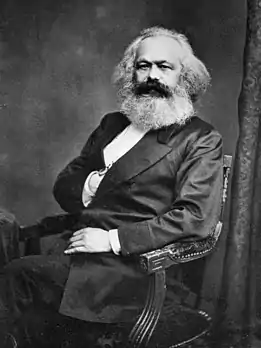Market structure
Market Structure in economics, depicts how firms are differentiated and categorised based on types of goods they sell (homogeneous/heterogeneous) and how their operations are affected by external factors and elements. Market structure makes it easier to understand the characteristics of diverse markets.

| Part of a series on |
| Economics |
|---|
|
History
Market Structure has been a topic of discussion for many economists like Adam Smith and Karl Marx who have strong conflicting viewpoints on how the market operates in presence of political influence. Adam Smith in his writing on economics stressed the importance of laissez-faire principles outlining the operation of the market in the absence of dominant political mechanisms of control, while Karl Marx discussed the working of the market in the presence of a controlled economy [1]sometimes referred to as a command economy in the literature. Both types of market structure have been in historical evidence throughout the twentieth century and twenty-first century.
Types
Based on the factors that decide the structure of the market, the main forms of market structure are as follows:
- Perfect competition, refers to type of market where there are many buyers that features low barriers to entry, many sellers, dealing with homogeneous products with no differentiation, where price is fixed by the market. Individual firms are price taker[2] as the price is set by the industry as a whole. Example: Agricultural products which have many buyers and sellers, selling homogeneous goods where the price is determined by the demand and supply of the market and not individual firms.
- Imperfect Competition refers to markets where standards for perfect competition is not fulfilled (such as no barriers for entry and exit, homogeneous products and many buyers and sellers). All other types of competition come under imperfect competition.
- Monopolistic competition, a type of imperfect competition where there are many sellers, selling products which are closely related but differentiated from one another (e.g. quality of products may differentiate) and hence they are not perfect substitutes. This market structure exists when there are multiple sellers who attempt to seem different from one another. Examples: toothpaste, soft drinks, clothing as they all are homogeneous products with many buyers and sellers, no to low entry barriers but are different from each other due to quality, taste, branding. Firms have partial control over the price as they are not price takers (due to differentiated products) or Price Maker (as there are many buyers and sellers). [3]
- Oligopoly, refers to market structure where only small number of firms operate together control the majority of the market share. Firms are neither price takers or makers. Firms tend to avoid price war by following price rigidity. They closely monitor the prices of their competitors and change prices accordingly. Oligopoly firms focus on quality and efficiency of their products to compete with other firms. Example: Network providers[4] ( Entry barriers, Small number of sellers, many buyers, products can be homogeneous or differentiated). Three types of oligopoly:
- Duopoly, a special case of an oligopoly where two firms operate and have power over the market.[5] Example: Aircraft manufactures: Boeing and Airbus
- Monopsony, when there is only a single buyer in a market. Example: Labour
- Oligopsony, a market where many sellers can be present but meet only a few buyers. Example: Cocoa producers
- Monopoly, where there is only one seller of a product or service which has no substitute. The firm is the price maker as they have control over the industry. There are high barriers to entry. Example: Google
- Natural monopoly, a monopoly in which economies of scale cause efficiency to increase continuously with the size of the firm. A firm is a natural monopoly if it is able to serve the entire market demand at a lower cost than any combination of two or more smaller, more specialized firms.
- Or natural obstacles, such as the sole ownership of natural resources, De beers was a monopoly in the diamond industry for years.
Features of market structures
The imperfectly competitive structure is quite identical to the realistic market conditions where some monopolistic competitors, monopolists, oligopolists, and duopolists exist and dominate the market conditions. The elements of Market Structure include the number and size of sellers, entry and exit barriers, nature of product, price, selling costs.
Competition is useful because it reveals actual customer demand and induces the seller (operator) to provide service quality levels and price levels that buyers (customers) want, typically subject to the seller's financial need to cover its costs. In other words, competition can align the seller's interests with the buyer's interests and can cause the seller to reveal his true costs and other private information. In the absence of perfect competition, three basic approaches can be adopted to deal with problems related to the control of market power and an asymmetry between the government and the operator with respect to objectives and information: (a) subjecting the operator to competitive pressures, (b) gathering information on the operator and the market, and (c) applying incentive regulation.[6]
| Market Structure | Seller Entry & Exit Barriers | Nature of product | Number of sellers | Number of buyers | Price |
|---|---|---|---|---|---|
| Perfect Competition | No | Homogeneous | Many | Many | Uniform price as their price takers |
| Monopolistic competition | No | Closely related but differentiated | Many | Many | Partial control over price |
| Monopoly | Yes | Differentiated (No Substitute) | One | Many | Price Maker |
| Duopoly | Yes | Homogeneous or Differentiated | Two | Many | Price rigidity due to price war |
| Oligopoly | Yes | Homogeneous or Differentiated | Few | Many | Price rigidity due to price war |
| Monopsony | No | Homogeneous or Differentiated | Many | One | Price taker (as there is only one buyer) |
| Oligopsony | No | Homogeneous or Differentiated | Many | Few | Price Taker |

The correct sequence of the market structure from most to least competitive is perfect competition, imperfect competition, oligopoly, and pure monopoly.
The main criteria by which one can distinguish between different market structures are: the number and size of firms and consumers in the market, the type of goods and services being traded, and the degree to which information can flow freely. In today's time, Karl Marx's theory about political influence on market makes sense as firms and industry are affected strongly by the regulation, taxes, tariffs, patents imposed by the government. These affect the barriers to entry and exit for the firms in the market.
See also
References
- Kenton, Will. "Karl Marx". Investopedia. Retrieved 2020-11-05.
- Mirman, Leonard J.; Salgueiro, Egas; Santugini, Marc (2015-09-08). "Learning in a Perfectly Competitive Market". Rochester, NY. Cite journal requires
|journal=(help) - Bykadorov, I.A., Kokovin, S.G. & Zhelobod’ko, E.V. Product diversity in a vertical distribution channel under monopolistic competition. Autom Remote Control 75, 1503–1524 (2014). https://doi-org.ezproxy.library.uq.edu.au/10.1134/S0005117914080141
- Cominetti, Roberto; Correa, José R.; Stier-Moses, Nicolás E. (2009-06-03). "The Impact of Oligopolistic Competition in Networks". Operations Research. 57 (6): 1421–1437. doi:10.1287/opre.1080.0653. ISSN 0030-364X.
- "Duopoly". Intelligent Economist. 2019-04-15. Retrieved 2020-11-05.
- Body of Knowledge on Infrastructure Regulation “Market Structure: Introduction.”
External links
| Library resources about Market structure |
 Media related to Markets at Wikimedia Commons
Media related to Markets at Wikimedia Commons- Microeconomics by Elmer G. Wiens: Online Interactive Models of Oligopoly, Differentiated Oligopoly, and Monopolistic Competition